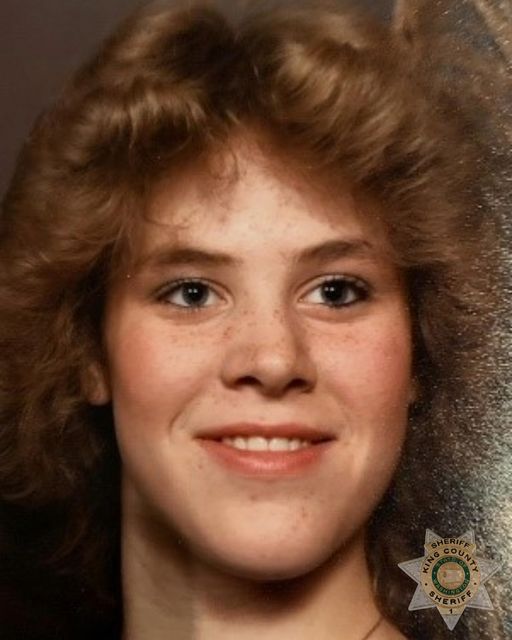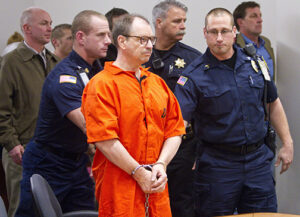
It was the kind of dumb argument every parent has with every teenager.
Lori Anne Razpotnik, age 15, wanted a horse. A friend had one, all Lori had to do, she told her mom, was pay for feed and pay to rent the stall.
Donna Hurley, her mother, said no. She didn’t have the money, she didn’t have the time. Her husband had died a decade prior, she was a single mother raising two teenagers. It wasn’t practical.
Lori was incensed. When she’d hit her teenage years she’d started rebelling — skipping school, shoplifting, she’d run away from their Lewis County home a few times. She ran away again.
“I told her no, and away she went,” Hurley recalled. The year was 1982.
She never saw Lori again.

Lori’s disappearance would remain a mystery, an open wound, an aching phantom limb, for more than four decades, until her remains were identified last month as one of at least 49 victims of Gary L. Ridgway, the Green River Killer.
Ridgway terrorized the Seattle region during the 1980s and early 1990s, abducting and killing young women, many of them runaways or sex workers. He was arrested in 2001 and eventually pleaded guilty to 49 murders. He is currently in Washington State Penitentiary in Walla Walla, serving 49 consecutive life sentences. Lori is the 48th victim to be identified.
For Hurley, 76, Lori’s disappearance, her absence, her death, have been an ever-present void, for more than 40 years.
“I guess everybody calls it closure, but to me it was just a relief,” Hurley said of Lori’s identification. “All of the what ifs, how come, where has she been, all the questions that go through your mind, you quit trying to fool yourself that she’s alive and well, raising a family and everything is good. It’s just a relief that all of that is off your shoulders and off your mind.”
“As a mother, part of me was still in denial. You build a wall around these things,” she said. “The tough thing is those walls start to crumble.”
Lori, she said, was a “firecracker,” interested in everything — sports, the outdoors, horses, cooking, dogs.
She played baseball and ran track. She liked to snowmobile. At 7 she trained the family Labrador retriever — Ebony’s Flippy Miss, but known as Flip — and showed her in a dog show.
“She could get A’s without opening her books,” Hurley said.
Hurley did speak with her daughter one time after she ran away. It was Thanksgiving, either 1982 or 83. Lori called her grandparents’ home, where the family was gathered. She told them she would be sending Christmas presents.
She said she was living in Seattle. She said she was happy.
The search
Hurley was unloading groceries in front of her Juneau, Alaska, home, one day in September, when two men approached. They said they were detectives with the King County Sheriff’s Office, and she invited them inside.
They told Hurley they believed they had identified Lori.
“I went ‘oh no’ and then I just went into shock, there’s no other way to say it,” she said. “I went through all the motions like a robot.”
They asked her for a saliva sample to confirm the DNA matched. The confirmation was the result of a yearlong effort combining cutting-edge, newly available DNA technology, with old-fashioned, scavenger hunt detective work — scouring birth records, death certificates, obituaries, until researchers found Lori.
Lori’s remains were discovered in 1985, about three years after she ran away from home. Auburn city employees, investigating a car crash on an embankment near Mountain View Cemetery, found two sets of human remains. They were labeled Bones 16 and Bones 17. They were found a few hundred yards from where remains had been found two years earlier.
After Ridgway’s arrest, as part of a plea deal to avoid the death penalty, he led police to the location, confirming that the still-unidentified remains were his victims. Bones 16 was identified in 2012 through DNA testing as 20-year-old Sandra Denise Major.
Traditional DNA testing can match a person’s DNA to a member of their immediate family. Tests of Bones 17 continually came up empty.
In 2022, King County contracted with Parabon NanoLabs, a DNA testing company that uses newer technology that can generate hits for much more distant relatives.
Traditional DNA testing tries to make matches based on about 20 genetic markers within DNA; Parabon uses nearly 1 million genetic markers, said CeCe Moore, the company’s chief genetic genealogist.
Parabon used DNA from Bones 17 to sequence the person’s entire genome, Moore said, and then uploaded the data to try to find matches with public DNA databases.
The largest and best-known databases — 23andMe, Ancestry and MyHeritage — generally do not cooperate with law enforcement. So Parabon uses two smaller databases, GEDmatch and Family Tree DNA, to look for matches.
“That’s when my job starts,” Moore said. “The scientists have done their work, then I start doing the genetic genealogy work.”
Moore works like a detective, using partial matches across many generations and multiple family trees to try to create a family tree, a lineage, for the unknown person.
Often, especially if there are close matches, it’s quick work.
“I can usually do it in a couple hours,” she said.
She worked on this case for more than a year.
The closest match turned out to be a deceased person, who then turned out to be adopted, which prompted an investigatory U-turn. She ended up using three dozen partial matches, building a family tree back to the 1600s, as distant as eighth cousins. Going back generations and generations, she found multiple adoptions, each one prompting a rethinking, a new draft of the family tree.
“There’s a misconception that we use one match or two matches in these cases but in reality we’re using many, many distant cousins,” Moore said. “We’re reverse-engineering someone’s identity based on who they share DNA with.”
She compared the work to a Sudoku puzzle, “you have to move things around until everything falls into place.”
Moore painstakingly built the family tree, but then ran into another roadblock. She thought she’d identified the immediate family, but couldn’t identify the individual person.
She knew she was looking for a teenage girl, but Lori had left little trace. She was so young when she disappeared, and she disappeared before social media, before online people searches, before the internet. She never voted, never bought property, never paid taxes. Moore scoured census records, birth announcements, yearbook photos. She came up empty.
It felt like she was chasing an apparition.
Then she stumbled upon an obituary. One paragraph on page 62 of the Jan. 19, 1972, Seattle Times.
Razpotnik, William S.
“Of Juneau, Alaska, formerly of Seattle. Husband of Donna. Father of William George and Lori Anne.”
Donna, she knew about. William George, Lori’s brother, she knew about.
“That was the first and only time I ever saw her name,” Moore said.
She wrote a report and sent it to King County. And then, more than a year after Moore started searching, more than 40 years after Lori disappeared, two detectives showed up on Donna Hurley’s doorstep.
“You become numb”
Hurley had left Centralia and moved to Juneau in the 1980s. Her parents lived there and the job prospects were better.
She worked in the hotel business for a decade, at a veterinarian’s office for 13 years, then for the Alaska Department of Education.
Now retired, she has two grandchildren and six great-grandchildren. They are Lori’s great and great-great-nieces and -nephews, although they never met her.
Hurley’s son died in 2010, of cancer, “just like his dad.”
Over the years, she saw news coverage of the Green River killer. She thought about it from time to time.
“We were in Alaska, we were so far removed,” she said. “I was still raising my son, I was trying to push all of it out of my mind.”
Law enforcement would post pictures and police sketches of victims.
“I never saw anyone that I felt looked like Lori,” she said.
Police posted a composite image of Bones 17, what they imagined she might look like, based on DNA. Blondish hair, blue-green eyes, fair complexion.
“It took me a long time to admit it looked like her,” Hurley said. The composite image had straight hair, she thought to herself, but Lori had curly hair. “A lot of it was denial.”
“You become numb at a certain point. It’s just,” she paused, searching for words. “It makes me sad that her life ended that way, makes me angry at the person who did it, makes me angry at myself that I couldn’t stop it, and at a certain point you just have to realize that you have another part of your family that you have to keep going forward for.”
Lori’s idol, Hurley said, was her dad. She doesn’t think Lori ever got over his death, when she was only 5. “She was daddy’s little girl, she had the curly ponytails and the big blue eyes.”
She plans to bury Lori at Evergreen Washelli Cemetery in Seattle, next to her dad.
This story has been republished with permission from the original at The Seattle Times.
…
Continue reading this article at; alaskapublic.org
Author : David Gutman, The Seattle Times
Alaska Public Media
https://alaskapublic.org/2024/01/04/how-dna-and-an-obituary-helped-id-a-victim-of-the-green-river-killer/
National,News,Public Safety,Top Stories
#DNA #obituary #helped #victim #Green #River #killer
